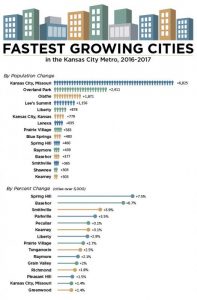Known as the “City of Fountains,” Kansas City could be just a year away from passing the 500,000 population mark which will make it 40 percent larger than its arch rival across the state–St. Louis. While a much larger metropolitan area over-all, St. Louis lost 4,518 people in 2017 while KC has gained 6,825 new residents and remained the region’s fastest growing. It hasn’t been above the 500,000 mark since the early 1970s.
In the last year, St. Louis dropped out of the top 20, Kansas City remains the 30th largest metro area in the country with 2,100,000 people. KC continues to edge out Austin, Texas; Cleveland; Columbus, Ohio; and Indianapolis. Overall the Kansas City metro grew by more than 22,500 people from mid-2016 to mid-2017
 One reason for the growth of Kansas City, in addition to its revitalized central city, is the relatively low cost of housing that is shared with other fast growing cities in “fly-over country”.
One reason for the growth of Kansas City, in addition to its revitalized central city, is the relatively low cost of housing that is shared with other fast growing cities in “fly-over country”.
The high cost of housing seems to have sapped Americans’ taste for coastal cities last year as cities in Texas and Arizona gained more population than New York City or Los Angeles for the first time in a decade, according to census population estimates released today.
“What started as a promising decade for big cities is starting to crumble a little bit for them,” said William Frey, a demographer at the Brookings Institution, in an email. “The Great Recession put the brakes on dispersal to small metro areas, suburbs and the Sun Belt; but those trends are beginning to resume again.”
San Antonio’s population grew by 24,200 between 2016 and 2017, the largest gain among cities, with Phoenix not far behind at 24,000.
It was the first time since 2007 that New York City did not lead the pack in population growth. That year, New Orleans added almost 39,000 residents as people started going back home after Hurricane Katrina.
The last time a Texas city had the largest population surge was in 2006, when Houston — a major destination for Katrina evacuees — added about 43,000 people.
One factor, based on earlier census releases, is that more people have been moving out of New York City and Los Angeles, making it harder for those cities to maintain population growth just through births and immigration. By contrast, people continue to move into more affordable cities like San Antonio and Phoenix.
New York City’s overall population grew slightly between 2016 and 2017, but 143,000 more people moved out than moved in. During the same period, Phoenix’s Maricopa County attracted more than 39,000 new residents and San Antonio’s Bexar County added 10,000. (Numbers on movers are available by county, not by city).
The high and rising cost of living in coastal metropolises seems to be playing a role. The typical Los Angeles or New York City homeowner, for example, spends close to 30 percent of her income on mortgage and taxes, compared with about 22 percent in San Antonio and Phoenix.
San Antonio’s burgeoning population is causing traffic congestion. But Keith Phillips, an economist and assistant vice president of the San Antonio Federal Reserve, said that home prices well below state and national averages have been attracting companies and retirees.
Lawrence Yun, chief economist at the National Association of Realtors, said Texas and Arizona cities have gained population because of relatively low home prices and relatively strong job creation that he attributes to low-tax policies drawing more employers.
Population growth slowed in most cities of more than a million people, except San Antonio and Philadelphia.
For the second year in a row, Baltimore lost more people than any city, about 5,000. Also losing population were Chicago, Anchorage and Pittsburgh. In fact, Kansas City was one of the few older established cities to gain significant population.
Opportunity as well as affordability may be spreading to smaller towns, recent county population data shows. Cities with between 20,000 and 30,000 residents saw increasing rates of population growth for the third straight year, adding 104,000 people as a group from 2016 to 2017.
As for the suburbs, Lee’s Summit is quickly gaining on Independence and could become the fifth most populous city in Missouri behind KC, St. Louis, Springfield and Columbia. Independence dropped from 4th to 5th place last year as it was surpassed by Columbia.
–Metro Voice
 Metro Voice News Celebrating Faith, Family & Community
Metro Voice News Celebrating Faith, Family & Community 







